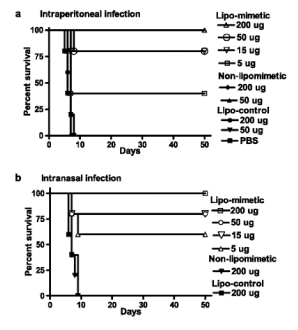
 |
| Figure 3: IFNγ(95-132) protects mice against vaccinia virus infection. a, i.p. route of infection with vaccinia virus. C57BL/6 mice (n = 5) were injected i.p. on days –2, –1, and 0 with the following peptides: Lipo-IFNγ(95-132) was given at 200 µg (△), 50 µg (○), 15 µg (▽), or 5 µg (☐). ■, PBS-injected control. Control peptide lipo-IFNγ(95–125) was given at 200 µg (●) or 50 µg (▼). Nonlipo- IFNγ(95-132) was given at 200 µg (◆) or 50 µg (▲). On day 0, mice were injected i.p. with 107 PFU of vaccinia virus in a volume of 100 µl with PBS. Survival was followed for >50 days. The significance of difference between different treatment groups was measured by log rank survival method, which gave p values of 0.002, 0.004, 0.009, and 0.03 for administration of 200, 50, 15, and 5 µg per mouse of lipo-mimetic vs the control lipopeptide. b, Intranasal route of infection with vaccinia virus. Mice (n = 5) were injected i.p. with the following peptides. Lipo-IFNγ(95-132) was given at 200 µg (☐), 50 µg (○), 15 µg (▽), or 5 µg (△). Control peptide, lipo-IFNγ(95–125) (■), or nonlipophilic IFNγ(95-132) (▼) were given at 200 µg. On day 0, mice were given 106 PFU of vaccinia virus in a volume of 10 µl intranasally. Survival was followed for 50 days. The significance of difference between different treatment groups was measured by log rank survival method, which gave p values of 0.0018, 0.0045, 0.012, and 0.03 for administration of 200, 50, 15, and 5 µg/mouse of lipomimetic vs the control lipo-peptide. Data from ref. 46. |